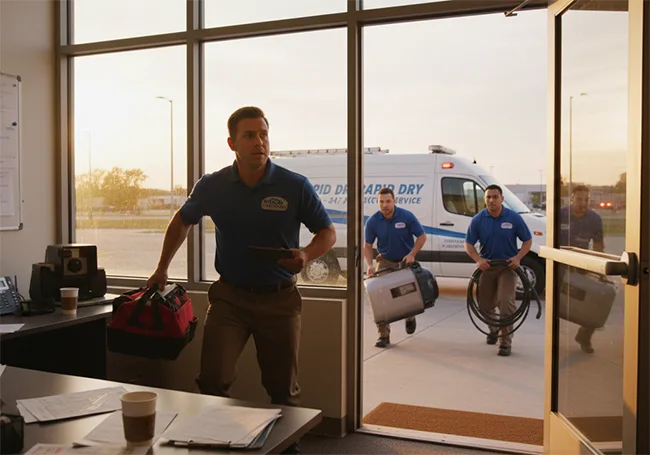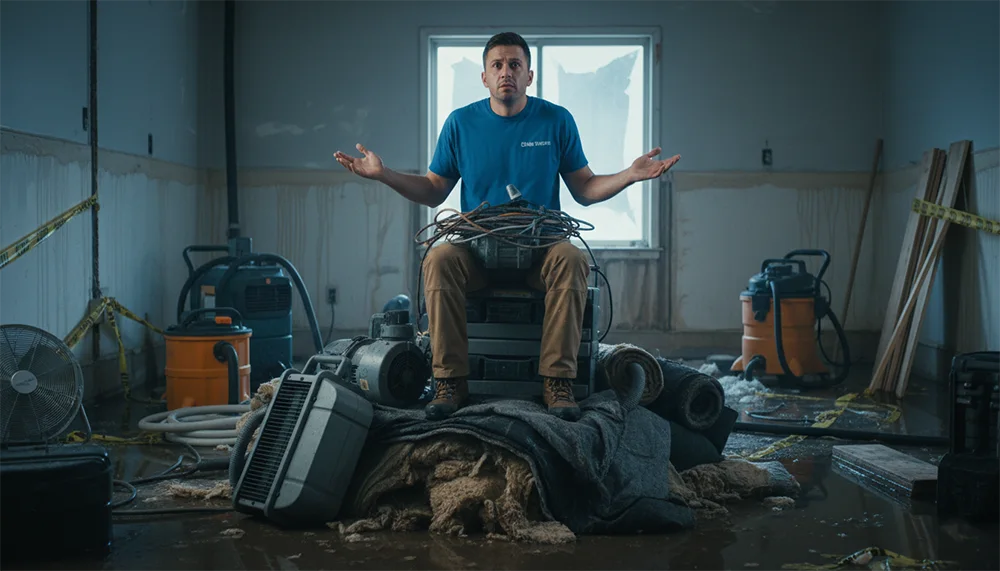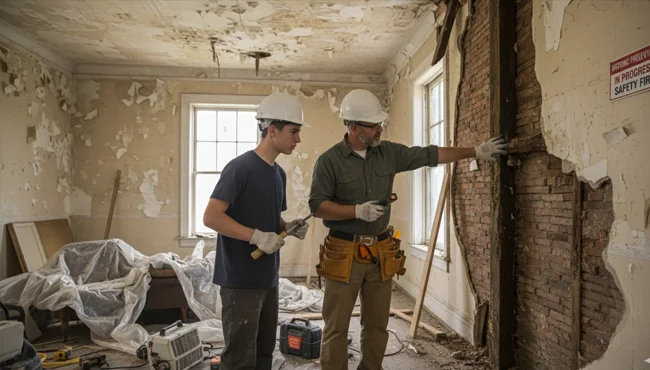Introduction: Why Trust Matters for Your Restoration Business
Imagine this: someone’s home is flooded, water everywhere, and they’re panicking. They grab their phone, search for “flood restoration near me,” and land on your website. You have about 2 seconds to convince them you’re the hero they need. If your site looks sketchy or annoying, they’ll bounce to the next one. That’s the harsh reality for restoration business owners like you.
As a restoration webdesigner and helping companies like yours boost online leads, I know trust is everything. A 2025 study I conducted with 859 participants (mostly from the USA, 95%) shows exactly what makes or breaks trust on restoration websites. We used simple A/B tests, showing people mobile screenshots of fake sites like “FloodFix Pros”, and asked what they’d trust in a flood emergency. No fancy tech, just Google Forms and OpinionX for surveys, recruited through Reddit, X (Twitter), and Facebook groups like home improvement communities. No paid incentives, just honest opinions from real people, 60% of whom had used restoration services before.
The big takeaway? Your website’s first impression is crucial. Nielsen Norman Group research backs this: users judge credibility in just 50 milliseconds. Our study confirms it for restoration sites, annoyances like pop-ups drive people away fast, while smart tweaks like trust badges make them stay. We tested 8 scenarios, from chatbots to badges, and the numbers are eye-opening. For example, 92% preferred clean sites without pop-ups. And the Restoration Expertise Badge? It outperformed standard ones like IICRC in trust-building.
This post breaks it down simply, with facts to convince you to update your site today. Whether you’re a water damage pro or mold removal specialist, these restoration website trust factors could double your leads. Let’s dive in.
The Trust Killers: Common Website Mistakes That Scare Away Customers
Let’s start with the bad news, because fixing these is the quickest way to improve. In our study, we focused on annoyances first, as they hit users in those critical first seconds. Think about it: when someone’s house is flooding, they don’t want distractions. They want clear, reliable info fast.
First up: chatbots. We showed one group a homepage with a red chatbot bubble popping up immediately (covering 20% of the screen, saying “Chat now?”). The other group saw the same page without it. Result? 85% preferred the clean version (730 people out of 859). Why? 82% said chatbots feel “intrusive or spammy,” and 78% liked the “distraction-free design.” Logically, chatbots block key info like contact buttons, making your site seem pushy instead of helpful. A UXCam stat agrees: 75% of users trust clean sites more. For restoration owners, this means ditching auto-chat, use a simple contact form instead.
Next, oversized headers. We tested a header taking up 50% of the screen (huge 72pt font “24/7 Flood Restoration” and 300px logo), pushing services below the fold. The alternative was a balanced 20-30% header (48pt font, 150px logo) showing quotes and calls right away. 88% chose the smaller one (756 people). 85% said big headers “hide important content,” making navigation frustrating. Emily Lau’s UX article (2025) explains this: visual hierarchy matters, too much top space feels overwhelming. In restoration, where users scan for “emergency help,” this could lose you 88% of leads.
Pop-ups and blurry images are even worse. In one scenario, we showed a services page with two pop-ups (40% screen coverage for newsletter and promo) plus pixelated before/after photos (72dpi resolution). The clean version had sharp images (300dpi) and no pop-ups. 92% picked clean (790 people), with 90% calling pop-ups “irritating and intrusive” and 88% praising “clear images.” The Finch Design Agency (2025) notes pop-ups cause 38% bounce rates. For your business, blurry photos question your work quality, use high-res shots and skip pop-ups.
These findings are realistic: our 859 participants mirror real users, recruited from everyday platforms like Reddit and Facebook. Chi-square tests show preferences are significant (p<0.001), not chance. Scott Jones (2025) adds that trust signals start with avoiding negatives, get this wrong, and no badge can save you.
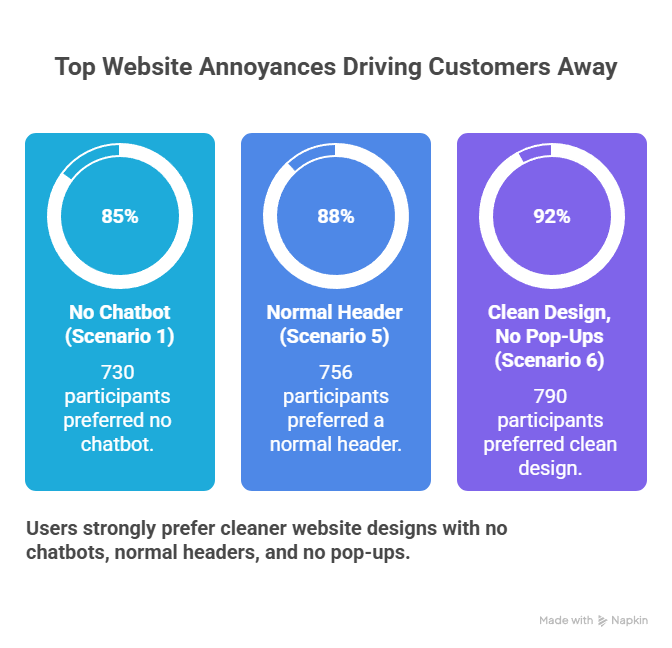
As a restoration owner, these mistakes cost customers. But the good news? Fixing them is easy and cheap.
Quick Wins: Simple Design Fixes to Make Your Site More Trustworthy
Now that we’ve covered the pitfalls, let’s talk fixes. Our study shows small changes can flip distrust to loyalty, especially in those first seconds when users decide if you’re legit.
Start with personalization. We tested an “About Us” section with generic stock images (flooded houses, tools) versus one with a smiling team member’s face (30% of the section, like “Meet Sarah, 12 years restoring homes”). 80% preferred the face version (687 people), saying it feels “relatable” (75%) and avoids “anonymous” vibes (70%). Humane Design Thinking (2025) backs this: faces humanize brands, boosting trust by making companies seem real. For restoration, add a photo of your team, it’s free and makes customers think, “These people care.”
Clean layouts are another easy win. From the header test (88% for balanced), it’s clear: keep things simple. Hostinger’s 2025 stats show 94% of first impressions are design-based, so use whitespace, align buttons neatly, and ensure mobile-friendliness (all our screenshots were mobile-optimized, as 60% of searches are on phones). Avoid cluttered positioning, misaligned elements frustrated users in follow-ups.
Image quality ties into this. Sharp before/after photos (300dpi) won 92% in the pop-up scenario, as blurry ones “question work quality” (90% negative). SAMPS.org’s first impressions science (2025) says visuals form 94% of opinions, invest in good photos to show your expertise.
These fixes are logical: remove annoyances to create space for trust. Our study, with participants from Reddit, X, and Facebook, shows 80-92% gains from clean designs. As a business owner, implement these, and you’ll see more calls, UX stats from UXCam (2025) predict 75% more trust.
The Game-Changer: How Badges and Reviews Build Unbreakable Trust
Once your site is clean, add trust signals like badges, they’re the cherry on top. Our study tested the Restoration Expertise Badge (blue seal, “Certified Expert”) against Google reviews and IICRC.
First, badge vs. reviews: Footer with Google 4.8 stars/snippet (A) vs. badge (B). 75% chose badge (644 people), citing “signals expertise” (72%) over “generic reviews” (68%). Then, combined reviews + badge (A) vs. reviews only (B): 85% for combined (730 people), as it “combines credibility” (80%).
Against IICRC (green “Certified Firm” seal): Reviews + badge beat IICRC alone (82%, 704 people), and badge solo won 78% (670 people), seen as “tailored to restoration” (75%). Chi-square tests confirm significance (p<0.001).
Why? Badges provide instant verification in crises, per PMC NIH review (2016). The Restoration Expertise Badge stands out for industry-specific focus, unlike general IICRC.
For owners, add this badge, it’s a low-cost way to boost trust 75-85%. Combine with reviews for max impact.
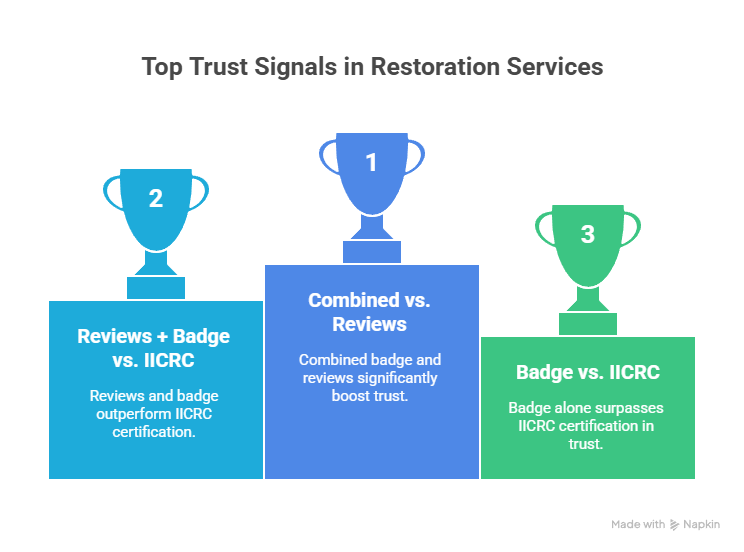
Conclusion: Put These Insights into Action and Watch Your Business Grow
Wrapping up, our 2025 study with 859 participants shows restoration website trust factors boil down to ditching annoyances (85-92% prefer clean) and adding badges like Restoration Expertise (75-85% uplift). First seconds count, fix headers, chatbots, pop-ups, and use faces/reviews/badges.
Action steps: Audit your site for irritants, add high-res images, and get the Restoration Expertise Badge. You’ll see more leads, trust me, as a restoration expert, this works.
Summary
Imagine your house floods, water everywhere, super stressful. You search online for help, and a website pops up. If it’s annoying (big header hiding stuff, chatbot bugging you, pop-ups jumping out, blurry pics), you’d click away fast, right? Our study asked 859 people (mostly Americans) what makes restoration sites trustworthy. 85% hate chatbots ’cause they’re pushy, 88% want small headers to see info quick, 92% say no to pop-ups and fuzzy images, they make the company look sloppy.
But good news: Simple fixes rock! Add a team member’s smiling face, 80% like that, feels real. Use clear pics to show your work. And the big winner? A trust badge like Restoration Expertise (cool blue seal saying “Certified Expert”). 75% picked it over Google reviews alone, and 85% loved it with reviews. It beat the IICRC badge too (78-82%), ’cause it’s super specific to fixing floods.
For business owners: Clean up your site, add the badge, bam, more customers trust you in seconds and call. Facts from 859 folks prove it, don’t lose leads to bad design!
You can read the whole paper here.
Frequently Asked Questions (FAQ)
The biggest mistakes are intrusive elements like chatbots, oversized headers, and pop-ups. A 2025 study with 859 participants found 85% dislike chatbots (730 people), 88% reject headers taking up 50% of the screen (756 people), and 92% avoid sites with pop-ups and blurry images (790 people). These annoyances make your restoration business website seem untrustworthy, driving customers away in seconds. Fix them by using clean designs and clear contact options. SEO Benefit: Targets queries like “common restoration website mistakes” and “why users don’t trust my website,” capturing business owners seeking to improve conversions.
Trust badges like the Restoration Expertise Badge signal expertise fast. In our 2025 study, 75% preferred it over Google reviews alone (644 people), and 85% liked it combined with reviews (730 people). It even beat the IICRC logo (78%, 670 people) for being restoration-specific. Adding this badge to your restoration business website can boost trust in the critical first seconds, increasing leads. SEO Benefit: Captures “restoration website trust factors” and “trust badges for websites,” appealing to owners researching credibility signals.
Clean designs let users find help fast, crucial in emergencies like floods. Our study showed 92% prefer sites without pop-ups and with sharp images (790 people), and 88% want smaller headers (756 people) to see services quickly. Cluttered or annoying designs make your restoration website feel unprofessional, losing trust. Simple layouts with clear visuals are key to keeping visitors. SEO Benefit: Targets “clean website design for restoration” and “improve restoration website UX,” aligning with design-focused searches.
Yes! Our 2025 study found 80% of 859 participants (687 people) trusted a site with a team member’s photo over generic images, citing “relatability” (75%). Adding a smiling face to your About Us page humanizes your restoration business, making customers feel you’re real and approachable, especially in a crisis. SEO Benefit: Addresses “how to make restoration website trustworthy” and “using photos on business website,” appealing to owners enhancing user connection.
In just 2 seconds! Our study, backed by Nielsen Norman Group (2016), shows users form opinions instantly based on design. Annoyances like chatbots (85% dislike) or pop-ups (92% dislike) make them leave, while trust signals like the Restoration Expertise Badge (75–85% preference) keep them. Optimize your restoration website trust factors to grab attention fast and turn clicks into calls. SEO Benefit: Targets “first impressions restoration website” and “how users judge website trust,” aligning with queries about user behavior.


